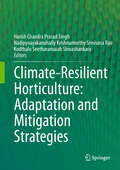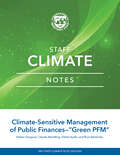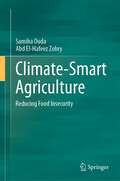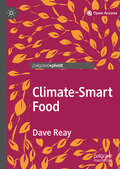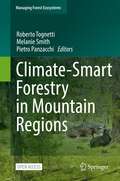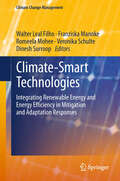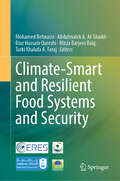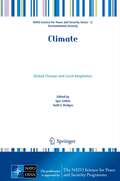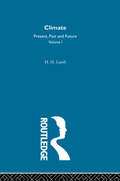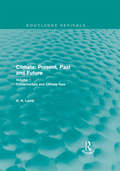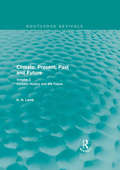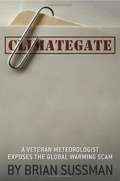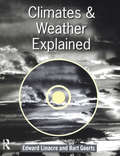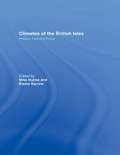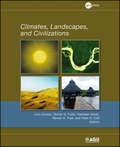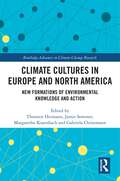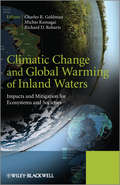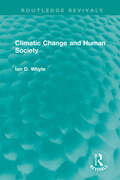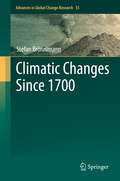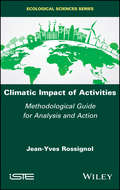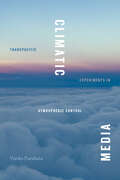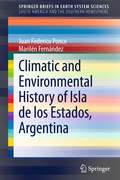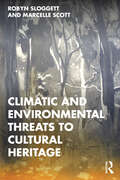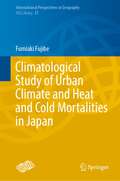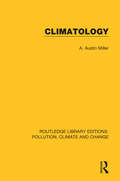- Table View
- List View
Climate-Resilient Horticulture: Adaptation And Mitigation Strategies
by Nadipynayakanahally Krishnamurthy Rao Kodthalu Seetharamaiah Shivashankar Harish Chandra SinghClimate change, a global phenomenon, has attracted scientists to contribute in anticipatory research to mitigate adverse impacts, which are more important for horticulture, considering that the scenario is in the midst of revolution, reaching the production level of 250 million tonnes in India. Impacts of climate variability have, invariably, profound influence on production and quality. An understanding of the impacts and relevant adaptation strategies are of foremost importance to sustain the productivity and profitability of horticulture crops in the climate change scenario, which necessitates synthesis of current knowledge to develop strategies for adaptation and mitigation to achieve climate-resilient horticulture. The book Climate-resilient horticulture: adaptation and mitigation strategies addresses the effects of climate change on different horticultural crops and focuses on the adaptation strategies based on the scientific knowledge generated by the experts in different agro-climatic regions in India. Issues have been covered in various chapters to make this book a treasure of knowledge in horticulture vis-a-vis climate change. Some of the crops included in the book are apple, grapes, cashew, banana, litchi, mango, coconut, oil palm, potato, tomato, cucurbits and flowers. In addition to strategies to be adapted in these crops, various other important aspects like carbon sequestration, pests and diseases, and urban landscaping are also covered in the book. Information on climatic risks and adaptation options for resilience in horticultural crops and future strategies and information on pest and disease dynamics on horticultural crops in relation to climate change and available mitigation strategies have also been documented. The book is edited by Dr H P Singh, a visionary leader, and his colleagues, which will be highly valuable to research workers, students, policy planners and farmers to understand and checkmate the adverse effect of climate change, so as to convert weakness into opportunity.
Climate-Sensitive Management of Public Finances—"Green PFM"
by International Monetary FundA report from the International Monetary Fund.
Climate-Smart Agriculture: Reducing Food Insecurity
by Samiha Ouda Abd El-Hafeez ZohryThis book tackles the main feature of water-smart, soil-smart and crop-smart practices and their integration to sustainably enhance food production. The book includes some insights on the implications of using climate-smart practices in irrigated and rain-fed agriculture, and suggests approaches to eradicate the negative effects of water scarcity, climate variability and climate change. The book reviews the most important crops resilient to climate variability and their resistance to other biotic and abiotic stresses, and contains the existing practices in Egypt that achieved the three pillars of climate-smart agriculture
Climate-Smart Food
by Dave ReayThis open access book asks just how climate-smart our food really is. It follows an average day's worth of food and drink to see where it comes from, how far it travels, and the carbon price we all pay for it. From our breakfast tea and toast, through breaktime chocolate bar, to take-away supper, Dave Reay explores the weather extremes the world’s farmers are already dealing with, and what new threats climate change will bring. Readers will encounter heat waves and hurricanes, wildfires and deadly toxins, as well as some truly climate-smart solutions. In every case there are responses that could cut emissions while boosting resilience and livelihoods. Ultimately we are all in this together, our decisions on what food we buy and how we consume it send life-changing ripples right through the global web that is our food supply. As we face a future of 10 billion mouths to feed in a rapidly changing climate, it’s time to get to know our farmers and herders, our vintners and fisherfolk, a whole lot better.
Climate-Smart Forestry in Mountain Regions (Managing Forest Ecosystems #40)
by Melanie Smith Roberto Tognetti Pietro PanzacchiThis open access book offers a cross-sectoral reference for both managers and scientists interested in climate-smart forestry, focusing on mountain regions. It provides a comprehensive analysis on forest issues, facilitating the implementation of climate objectives. This book includes structured summaries of each chapter.Funded by the EU’s Horizon 2020 programme, CLIMO has brought together scientists and experts in continental and regional focus assessments through a cross-sectoral approach, facilitating the implementation of climate objectives. CLIMO has provided scientific analysis on issues including criteria and indicators, growth dynamics, management prescriptions, long-term perspectives, monitoring technologies, economic impacts, and governance tools.
Climate-Smart Technologies: Integrating Renewable Energy and Energy Efficiency in Mitigation and Adaptation Responses (Climate Change Management)
by Walter Leal Filho Romeela Mohee Dinesh Surroop Franziska Mannke Veronika SchulteThe book addresses the perceived need for a publication with looks at both, climate smart technologies and the integration of renewable energy and energy efficiency in mitigation and adaptation responses. Based on a set of papers submitted as part of the fifth on-line climate conference (CLIMATE 2012) and a major conference on renewable energy on island States held in Mauritius in 2012, the book provides a wealth of information on climate change strategies and the role of smart technologies. The book has been produced in the context of the project "Small Developing Island Renewable Energy Knowledge and Technology Transfer Network" (DIREKT), funded by the ACP Science and Technology Programme, an EU programme for cooperation between the European Union and the ACP region.
Climate-Smart and Resilient Food Systems and Security
by Mohamed Behnassi Mirza Barjees Baig Abdulmalek A. Al-Shaikh Riaz Hussain Qureshi Turki Khalufa A. FarajThis contributed book, as a part of a series of CERES publications, contributes to the scientific debate about the interlinkages between climate change, environment, and food systems. It highlights the opportunities to accelerate the transformation of such systems within the perspective of sustainable, inclusive, and climate-smart practices. Most chapters are based on empirical research particularly done in vulnerable and resource-constrained countries from the Global South (such as India, Kenya, Pakistan, South Asia, Sri Lanka, and Vietnam) and provide policy-oriented inputs and recommendations to guide change processes at multiple scales. This project has implications for research, innovation, and policy design.
Climate: Global Change and Local Adaptation (NATO Science for Peace and Security Series C: Environmental Security)
by Igor Linkov Todd S. BridgesRising sea levels and altered weather patterns are expected to significantly alter coastal and inland environments for humans, infrastructure and ecosystems. Potential land-use changes and population increases, coupled with uncertain predictions for sea level rise and storm frequency/intensity represent a significant planning challenge. While efforts to mitigate climate change continue, plans must be made to adapt to the risks that climate change poses to humans, infrastructure, and ecosystems alike. This book addresses integrated environmental assessment and management as part of the nexus of climate change adaptation. Risk analysis has emerged as a useful approach to guide assessment, communication and management of security risks. However, with respect to climate change, an integrated, multi-criteria, multi-hazard, risk-informed decision framework is desirable for evaluating adaptation strategies. The papers in Part 1 summarize societal and political needs for climate change adaptation. Part 2 includes papers summarizing the state of the art in climate change adaptation. Three further parts cover: the process of change in coastal regions, in inland regions, and, finally, the potential challenges to homeland security for national governments. Each of these parts reviews achievements, identifies gaps in current knowledge, and suggests research priorities.
Climate: Past, Present and Future (Routledge Revivals: A History Of Climate Changes Ser.)
by H. H. Lamb"First Published in 1972, Routledge is an imprint of Taylor & Francis, an informa company."
Climate: Volume 1: Fundamentals and Climate Now (Routledge Revivals: A History of Climate Changes)
by H. H. LambFirst published in 1972, this first volume of Professor Lamb’s study of our changing climate deals with the fundamentals of climate and climatology, as well as providing global data on the contemporary climates of the twentieth century.
Climate: Volume 2: Climatic History and the Future (Routledge Revivals: A History of Climate Changes)
by H. H. LambFirst published in 1977, the second volume of Climate: Present, Past and Future covers parts 3 and 4 of Professor Hubert Lamb’s seminal and pioneering study of climatology. Part 3 provides a survey of evidence of types of climates over the last million years, and of methods of dating that evidence. Through the earlier stages of the Earth’s development the book traces what is known of the various geographies presented by the drifting continents and indicates what can be learnt about climatic regimes and the causes of climatic change. From the last ice age to the present our knowledge of the succession of climates is summarized, indicating prevailing temperatures, rainfalls, wind and ocean current patterns where possible. Part 4 considers events during the fifteen years prior to the book’s initial publication, leading on to the problems of estimating the most probable future course of climatic development, and the influence of Man’s activities on climate. Alongside the reissue of volume 1, this Routledge Revival will be essential reading for anyone interested in both the causes and workings of climate and in the history of climatology itself.
Climategate: A Veteran Meteorologist Exposes the Global Warming Scam
by Brian SussmanDangerous winds are blowing across America's culture today, creating an atmosphere of extreme anxiety. So why is the government making things worse? Former TV meteorologist turned talk show host Brian Sussman wondered that for years, and a decade's worth of investigation has yielded one of the most shocking stories of our time. In CLIMATEGATE, Sussman uncovers the following: * Communist founders Marx and Engels drafted the inspiration that drives today's environmentalist leaders. * Despite rigorous government-sponsored efforts to alter the record, past climate was significantly warmer than today. * Though only a minuscule sliver of earth's atmosphere, carbon dioxide is an essential nutrient for life and, when increased, can prove quite beneficial. * Barack Obama's presidency is a dream come true for those seeking to use the environment to destroy the United States. * Global warming is a convenient theory that is allowing venture capitalists, international bankers and multinational corporations to reap billions--and fellow travelers to imagine a one-world government. * Al Gore's Oscar-winning film should be considered a work of fiction. * Government agencies, elitist politicians and environmentalists are working together to block the expansion of both alternative and traditional energy resources. * The United Nation's policies have worked their way directly into U.S. environmental laws. * The recently leaked e-mails from Great Britain's climate center are further confirmation of a years-long, complex cover-up. * Updating the nation's energy grid is designed to bring Big Brother inside our home. In his book, CLIMATEGATE, Sussman combines his keen ability to readily explain complex scientific subjects with his astute political observations, driving home his conviction: the theory of man-made global warming is a fraud and many of the high-profile personalities fronting such claims are charlatans purposed to change society and make loads of cash.
Climates and Weather Explained: An Introduction From A Southern Perspective: Instructor's Resource Pack (includes Students' And Instructors' Cd-rom)
by Bart Geerts Edward LinacreClimates and Weather Explained is a comprehensive introduction to the study of the atmosphere integrating climatology and meteorology. Clear explanations of basic principles, concepts and processes are supported by a wealth of highly informative illustrations and a vast array of case studies demonstrating the relevance of weather and climate to everyday life. Focusing particularly on the Southern hemisphere the authors provide fresh insights into topical environmental concerns from global warming and natural hazards to sustainable global population. The textbook is supplemented by a unique interactive Student CD-ROM containing entirely additional material, for practical work and more advanced study. Closely related to each chapter of the book, the Student CD-ROM features: * Over 170 extra 'Notes', 40 illustrations and tables. * Multiple choice, self-assessment and practical exercises. * Extended glossary and key word searching * Hypertext presentation and extensive cross-referencing * A gallery of meteorological photographs in full colour A special Instructors' Resource Pack is also available containing an additional Instuctors'CD-ROM. For further information visit: website address here
Climates of the British Isles: Present, Past and Future
by Mike Hulme Elaine BarrowOur understanding of climate and its role in human affairs has changed markedly over recent years, as have climate observation systems and modelling capabilities. Reliance on recent weather statistics to provide a guide for future climate is no longer viable. Evidence of human-induced climate change has placed climate high on political and the media agendas. Climates of the British Isles provides a comprehensive account of what we know about climate and changing climates at the end of the twentieth century. Integrating the historical and geographical dimensions of climate, the crucial link between past and future climatic conditions is examined through the geographical lens of the British Isles. Climates of past ages are reconstructed and full descriptions of present climate are illustrated by a wealth of graphs, maps and images. Important climate data sets are provided. Marking the twenty-fifth anniversary of the internationally acclaimed Climatic Research Unit, this book distils much of the leading research of present and recent members of the unit and presents an authoritative, accessible view of climatic change and prospects for the next millenium and beyond.
Climates, Landscapes, and Civilizations (Geophysical Monograph Series #198)
by Rowan K. Flad Dorian Q. Fuller Peter D. Clift Liviu Giosan Kathleen NicollPublished by the American Geophysical Union as part of the Geophysical Monograph Series, Volume 198.Climates, Landscapes, and Civilizations brings together a collection of studies on the history of complex interrelationships between humans and their environment by integrating Earth science with archeology and anthropology. At a time when climate change, overpopulation, and scarcity of resources are increasingly affecting our ways of life, the lessons of the past provide multiple reference frames that are valuable for informing our future decisions and action plans. Volume highlights include discussions of multiple connotations of the Anthropocene, landscapes as a link between climate and humans, synoptic approaches to explore large-scale cultural patterns, regional studies for contextualizing cultural complexity, and environmental determinism and social theory. Straddling the fields of Earth sciences, anthropology, and archaeology and presenting research from across several continents, Climates, Landscapes, and Civilizations will appeal to a wide readership among scientists, scholars, and the public at large.
Climate Cultures in Europe and North America: New Formations of Environmental Knowledge and Action (Routledge Advances in Climate Change Research)
by Thorsten HeimannBringing together scholarly research by climate experts working in different locations and social science disciplines, this book offers insights into how climate change is socially and culturally constructed. Whereas existing studies of climate cultural differences are predominantly rooted in a static understanding of culture, cultural globalization theory suggests that new formations emerge dynamically at different social and spatial scales. This volume gathers analyses of climate cultural formations within various spaces and regions in the United States and the European Union. It focuses particularly on the emergence of new social movements and coalitions devoted to fighting climate change on both sides of the Atlantic. Overall, Climate Cultures in Europe and North America provides empirical and theoretical findings that contribute to current debates on globalization, conflict and governance, as well as cultural and social change. This book will be of great interest to students and scholars of climate change, environmental policy and politics, environmental sociology, and cultural studies.
Climatic Change and Global Warming of Inland Waters
by Michio Kumagai Charles R. Goldman Richard D. RobartsEffects of global warming on the physical, chemical, ecological structure and function and biodiversity of freshwater ecosystems are not well understood and there are many opinions on how to adapt aquatic environments to global warming in order to minimize the negative effects of climate change. Climatic Change and Global Warming of Inland Waters presents a synthesis of the latest research on a whole range of inland water habitats - lakes, running water, wetlands - and offers novel and timely suggestions for future research, monitoring and adaptation strategies.A global approach, offered in this book, encompasses systems from the arctic to the Antarctic, including warm-water systems in the tropics and subtropics and presents a unique and useful source for all those looking for contemporary case studies and presentation of the latest research findings and discussion of mitigation and adaptation throughout the world. Edited by three of the leading limnologists in the field this book represents the latest developments with a focus not only on the impact of climate change on freshwater ecosystems but also offers a framework and suggestions for future management strategies and how these can be implemented in the future.Limnologists, Climate change biologists, fresh water ecologists, palaeoclimatologists and students taking relevant courses within the earth and environmental sciences will find this book invaluable. The book will also be of interest to planners, catchment managers and engineers looking for solutions to broader environmental problems but who need to consider freshwater ecology.
Climatic Change and Human Society (Routledge Revivals)
by Ian D. WhyteOriginally published in 1995, this book brings together material from many sources and offers a balanced appreciation of the ways in which climatic changes can interact with society. The questions it discusses are as relevant now as when the book was published: how far should governments go in taking expensive and unpopular measures to reduce greenhouse gas emissions? Will the warming trend produce results as dire as have been predicted? It does not presuppose a background in science and extensive use is made of case studies drawn from around the world to put scientific principles into context. An invaluable book for those approaching the subject for the first time.
Climatic Changes Since 1700 (Advances in Global Change Research #55)
by Stefan BrönnimannThe proposed book is not only a tribute to the work of Brückner (and indeed also a personal tribute, since Brückner wrote his book at the Institute of Geography of the University of Bern), but references to Brückner's book are also a conceptual tool in the proposed book, though used sparingly and thoughtfully. Apart from providing historical context, references may facilitate introducing some complex topics, for instance by first presenting Brückner's view and then complementing the picture with today's understanding. References can be used for contrast: Comparing Brückner's methods and data with today's research concepts makes the progress in the field easily understandable. The enormous growth of information since Brükner's time allows a much more detailed perspective on some scientific problems. Or references can be used to highlight similarity. Some aspects have not changed over time. Finally, the book complements Brückner's studies by adding the arguably most interesting and certainly most relevant period, the past 120 years.
Climatic Impact of Activities: Methodological Guide for Analysis and Action
by Jean-Yves RossignolWhere the environment is concerned, regardless of scale, the logic of the Native American hummingbird which "does its part" should prevail. To act independently of others is indeed the sine qua non of the global shift towards a regenerative economy of humanity and ecosystems, expurgating the pervading pollution (particularly from oil use). Small- and medium-sized enterprises, which this book especially targets, do not need disproportionately-sized study facilities in order to reduce their impact on global warming. Climatic Impact of Activities provides valuable methodological and practical support for establishing a complete and reliable diagnosis of the greenhouse effect, and for planning the corresponding corrective actions. This book guides the reader step by step in developing an informed emissions assessment with realistic and advanced case studies, in full compliance with official methodological recommendations.
Climatic Media: Transpacific Experiments in Atmospheric Control (Elements)
by Yuriko FuruhataIn Climatic Media, Yuriko Furuhata traces climate engineering from the early twentieth century to the present, emphasizing the legacies of Japan’s empire building and its Cold War alliance with the United States. Furuhata boldly expands the scope of media studies to consider technologies that chemically “condition” Earth’s atmosphere and socially “condition” the conduct of people, focusing on the attempts to monitor and modify indoor and outdoor atmospheres by Japanese scientists, technicians, architects, and artists in conjunction with their American counterparts. She charts the geopolitical contexts of what she calls climatic media by examining a range of technologies such as cloud seeding and artificial snowflakes, digital computing used for weather forecasting and weather control, cybernetics for urban planning and policing, Nakaya Fujiko’s fog sculpture, and the architectural experiments of Tange Lab and the Metabolists, who sought to design climate-controlled capsule housing and domed cities. Furuhata’s transpacific analysis offers a novel take on the elemental conditions of media and climate change.
Climatic and Environmental History of Isla de los Estados, Argentina (SpringerBriefs in Earth System Sciences #0)
by Juan Federico Ponce Marilén FernándezThis book is the result of ten years' of scientific research carried out by the authors on Isla de los Estados. The research includes their doctoral thesis and many published scientific papers related to the island. The book is divided into two principal parts. The first part covers different social and natural aspects of this remote island and includes chapters on the scientific and historical background, physiography with topographical and hydrographical descriptions, climate and oceanographic circulation, vegetation and geology (including stratigraphy, structural geology and geological history). The second part comprises a reconstruction of the paleoenvironmental, paleoclimatic and paleogeographic history of the island from the Last Glacial Maximum to the present, correlating with other paleoecological records from the southern part of Isla Grande de Tierra del Fuego and Patagonia. This second part also includes a geomorphological chapter with a characterization of the principal erosive glacial landforms on Isla de los Estados constructed by means of morphometric analysis, inventories, maps, paleogeographic and glacial models, and a paleoecological chapter evaluating the palaeoenvironment and palaeoclimatic conditions that prevailed during the Late Pleistocene-Holocene times based on pollen and diatom analysis from three 14C-dated peat bogs and lakes. Finally, the book concludes with a review of the island's archaeology and the relationship between the palaeoenvironmental history and human occupation of this island.
Climatic and Environmental Threats to Cultural Heritage
by Robyn Sloggett Marcelle ScottClimatic and Environmental Threats to Cultural Heritage examines the challenges that environmental change, both sudden and long-term, poses to the preservation of cultural material. Acknowledging the diversity of human cultural heritage across collecting institutions, heritage sites and communities, the book highlights how, in Australia, Southeast Asia and the Pacific, the quest to preserve such precious knowledge relies on records and narratives being available to inform decisions now and into the future. Bringing together a diverse range of stakeholders who have an interest in – and responsibility for – the care of cultural heritage material and places of cultural heritage value, the book explores their thinking on and actions in relation to issues of climate change and environmental risk. Sloggett and Scott highlight the stakeholders’ shared interest in drawing on their expertise to meet the challenges that environmental change brings to the future of our cultural heritage and our cultural identity. Based on the understanding that this global challenge requires local, national and international co‐operation, the book also considers how local knowledge can have international application. Climatic and Environmental Threats to Cultural Heritage will be of interest to those engaged in the study of heritage, conservation, archaeology, archives, anthropology, climate change and the environment. It will also be useful to practitioners and others attempting to understand the effect of environmental change on cultural heritage around the globe.
Climatological Study of Urban Climate and Heat and Cold Mortalities in Japan (International Perspectives in Geography #21)
by Fumiaki FujibeThis book describes observed features of urban climate and its long-term variations as well as the relationship of climate to heat stroke in Japan, based on observational data and statistical analyses. Consisting of three parts, the book is a valuable resource for researchers and professionals involved with these topics. Part 1 focuses on urban climate. The basic characteristics of heat islands are reviewed, and long-term urban warming is described with a focus on the distinction from global warming. The influence of microscale environmental changes on the observed temperature is also presented, as well as changes in wind and precipitation in urban areas. They deepen our understanding of the features and mechanisms of urban heat islands and their long-term changes. Part 2 describes the climatological features of heat stroke mortality, which has become a major social problem in Japan, using mortality statistics and meteorological data. The spatial and temporal variations of heat stroke mortality are analyzed quantitatively on various spatial and temporal scales. In addition, the number of ambulance transports is examined as another measure of heat stroke casualty. The results provide insight into the climatological factors related to heat stroke mortality and contribute to the implementation of preventive measures. The climatology of deaths from extreme cold is also presented. For supplementary information, an overview of the geography, climate, and meteorological data of Japan is presented in Part 3.
Climatology
by A. Austin MillerOriginally published in 1931 (this re-issues the 8th edition of 1953), this book gives students a comprehensive account of global climatic types and the impact of climate on economics, issues of race, health, meteorology and geography. Climate change is covered from earliest times up until the middle of the twentieth century. The material is supplemented with 82 black and white maps/diagrams.
